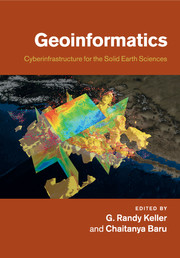Book contents
- Frontmatter
- Contents
- List of contributors
- Preface
- Introduction
- Part I Case studies from other disciplines
- Part II Modeling software and community codes
- Part III Visualization and data representation
- Part IV Knowledge management and data integration
- Part V Web services and scientific workflows
- Part VI Emerging international and other efforts
- 18 It's not your data, it's everyone's: The benefits of a corporate approach to scientific information
- 19 TOPO-EUROPE and cyberinfrastructure: Quantifying coupled deep earth – surface processes in 4-D
- 20 OneGeology – from concept to global project
- 21 Geoinformatics developments in Germany
- 22 iGEON: Networking the Indian geosciences community through GEON
- 23 Geoinformatics in the public service: Building a cyberinfrastructure across the geological surveys
- 24 Application of the US Geoscience Information Network to deploying a national geothermal data system
- Index
- Plate section
20 - OneGeology – from concept to global project
from Part VI - Emerging international and other efforts
Published online by Cambridge University Press: 25 October 2011
- Frontmatter
- Contents
- List of contributors
- Preface
- Introduction
- Part I Case studies from other disciplines
- Part II Modeling software and community codes
- Part III Visualization and data representation
- Part IV Knowledge management and data integration
- Part V Web services and scientific workflows
- Part VI Emerging international and other efforts
- 18 It's not your data, it's everyone's: The benefits of a corporate approach to scientific information
- 19 TOPO-EUROPE and cyberinfrastructure: Quantifying coupled deep earth – surface processes in 4-D
- 20 OneGeology – from concept to global project
- 21 Geoinformatics developments in Germany
- 22 iGEON: Networking the Indian geosciences community through GEON
- 23 Geoinformatics in the public service: Building a cyberinfrastructure across the geological surveys
- 24 Application of the US Geoscience Information Network to deploying a national geothermal data system
- Index
- Plate section
Summary
Background
The OneGeology concept originated in the UK in early 2006. With the potential stimulus of the UN International Year of Planet Earth (IYPE) very much in mind, an idea was opportunistically presented a few weeks later to the General Assembly of the Commission for the Geological Map of the World (CGMW) in Paris. The challenge laid down was: could we use IYPE to begin the creation of an interoperable digital geological dataset of the planet? Fourteen months later, the concept was unanimously endorsed by the international geoscience community at a meeting in Brighton, UK, and goals were set to achieve a global launch at the 33rd IGC in Oslo in August 2008. The goals that the Brighton meeting agreed for OneGeology were deceptively simple. They were to:
improve the accessibility of geological map data;
exchange know-how and skills so that all nations could participate; and
accelerate interoperability in the geosciences and the take up of a new “standard” (GeoSciML).
In Oslo 18 months later, the author, Simon Winchester, launched a fully operational project with 94 national participants, and 25 of those nations were already serving national map datasets through a state-of-the-art web map portal.
The current situation
Today there are 114 countries participating in OneGeology (Figure 20.1), more than 40 of which are serving data using a web map portal and protocols, registries, and technology to “harvest” and serve data from around the world (www.onegeology.org/).
- Type
- Chapter
- Information
- GeoinformaticsCyberinfrastructure for the Solid Earth Sciences, pp. 317 - 322Publisher: Cambridge University PressPrint publication year: 2011



